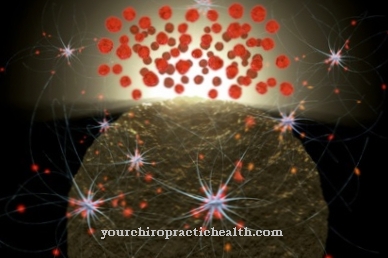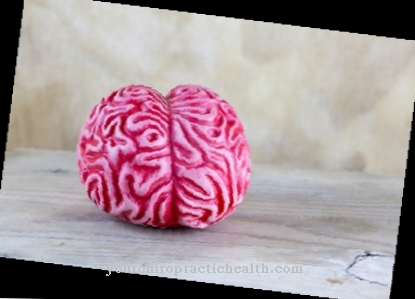Sugar metabolism is the synonymous term for Carbohydrate metabolism. It includes all processes for the absorption, conversion, synthesis and utilization of single and multiple sugars in the organism. A common disorder of carbohydrate metabolism is known as diabetes mellitus.
What is the sugar metabolism?

The sugar metabolism basically deals with all metabolic processes in which carbohydrates are involved. Its most important function is to provide energy for the organism. The liver is the central organ for carbohydrate metabolism, especially since it stores the complex carbohydrate glycogen as an energy reserve.
The carbohydrates are taken in as simple sugars (e.g. glucose), double sugars (disaccharose) or multiple sugars (complex carbohydrates such as starch) through food and processed by the body. The sugar metabolism is mainly controlled by the two hormones insulin and glucagon. While insulin lowers blood sugar levels, glucagon increases it.
The breakdown of carbohydrates (glycolysis) forms the backbone of the entire metabolism. This creates pyruvate (the salt of pyruvic acid), which plays a central role as an intermediate product in many metabolic pathways. If carbohydrates are not supplied through food, their synthesis from amino acids takes place in the body. Therefore, the human body is not necessarily dependent on carbohydrates in food. Nevertheless, a sugar metabolism takes place because glucose is constantly produced via this metabolic pathway.
Function & task
The body is supplied with energy via the sugar metabolism. The main sources of energy are the carbohydrates in food. They are available in the form of single sugars, double sugars (disaccharides) and multiple sugars (polysaccharides, starch).
Single and double sugars are immediately able to provide energy for the organism. However, the polysaccharides must first be split into glucose before they are absorbed by the intestine. The glucose gets into the blood and is transported through the body with the bloodstream to supply the organs with energy.
Glucose uptake occurs through the cell membranes with the help of insulin. If the blood sugar concentration increases due to the intake of carbohydrates, the islet cells of the pancreas are stimulated to secrete insulin via various regulating mechanisms. The insulin then binds to special membrane receptors in the body's cells and makes the membranes permeable to glucose.
If less energy is needed, insulin ensures that the excess glucose is absorbed by the liver, muscles and fat cells. In the liver and muscles, the glucose components are then reassembled into a polysaccharide (glycogen).
Glycogen is stored and used as an energy reserve when needed. In the fat cells, the glucose is converted into body fat and stored there as such. When blood sugar levels are too low, another hormone called glucagon is responsible for the production or release of glucose.
A blood sugar level that is too low occurs, for example, when you are hungry, when you have a high energy requirement or when your insulin output is too high. Glucagon takes care of the breakdown of glycogen or the conversion of amino acids into glucose. Thus, the interaction of insulin and glucagon ensures a balanced blood sugar level.
Due to the ability of glucagon to form glucose from amino acids, a carbohydrate intake through food is not absolutely necessary in humans. The necessary basic supply of glucose is guaranteed for important organs such as the brain in any case. In addition to glucose, the sugar metabolism also includes simple sugars such as fructose or galactose.
Illnesses & ailments
In connection with the sugar metabolism, the so-called diabetes mellitus, also known as diabetes, is the most important disease. Diabetes is characterized by an excessively high blood sugar level, which when fasting is already over 126 mg / dl. Prediabetes is suspected between 100 and 126 mg / dl.
The cause of the high blood sugar level can be the lack, deficiency or reduced effectiveness of insulin. Diabetes mellitus is not a uniform disease. For example, diabetes can be divided into two different types:
Type I diabetes mellitus is characterized by the lack or lack of insulin. This form of diabetes is often congenital or acquired early. Insulin deficiency can be caused by the destruction of the islets of Langerhans by an autoimmune disease or by being absent from birth. The patient is dependent on insulin for life. Otherwise the sugar could not be used.
Type II diabetes mellitus was often referred to as old-age diabetes because it usually occurred in old age. Today it often occurs in childhood or adolescence. The cause is acquired insulin resistance through poor diet, obesity, lack of exercise, smoking or drinking.
In this form of the disease, insulin is produced, but its effectiveness decreases because there are fewer and fewer insulin receptors. Due to the increasing insulin resistance, the pancreas (pancreas) has to produce more and more insulin without the blood sugar level dropping significantly. A vicious circle forms, which can lead to complete exhaustion of the pancreas.
If the blood sugar level is permanently high, the blood vessels and nerve endings are damaged in the long term. As a result, various complaints such as arteriosclerosis, circulatory disorders in the limbs, diabetic feet due to nerve damage, polyneuropathy, eye damage to blindness and much more occur.
In the early stages of the disease, the blood sugar level can be brought back to normal by changing your lifestyle. However, when the degenerative changes have progressed too far, diabetes is often the starting point for various chronic diseases. A low-carbohydrate diet and plenty of exercise can significantly improve sugar metabolism.




























.jpg)